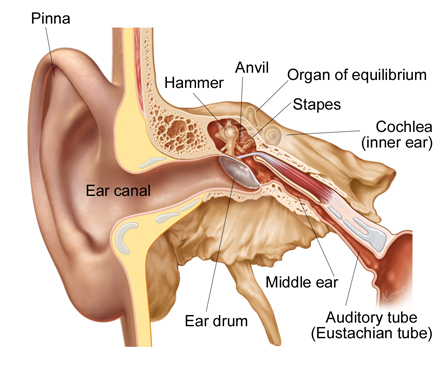A look inside the ear
Problems with pressure imbalance in the ear are often caused by failing the Eustachian tube to open. The Eustachian tube is also called the auditory tube or the "pharyngotympanic tube".
When describing your symptoms, your doctor may talk about "tube ventilation dysfunction" or a "Eustachian tube dysfunction".

What is Eustachian tube dysfunction?
The Eustachian tube is a small, tube-like structure that links the nasopharyngeal cavity with the middle ear. It consists of an elongated part made of cartilage which opens into the nasopharyngeal cavity, the part near the middle ear is short and bony. Every time we swallow, it opens briefly before immediately closing again. This equalises pressure between the middle and the outer ear. A soft "click" can be heard when this happens.
The uncomfortable feeling of pressure in the ear results from the eardrum swelling inwards or outwards, due to differences in air pressure in the middle ear and the environment. In a healthy ear, pressure can be equalised by swallowing, yawning or trying to breathe out with pinched nostrils. The symptoms – often experienced during air travel, while passing through rail tunnels, along mountain passes or when diving – then disappear. If the Eustachian tube is not ventilated properly, these methods do not work, however, and uncomfortable sensations such as feeling pressure and muffled hearing, do not go away. Experts estimate that about one in a hundred people are affected by this kind of Eustachian tube disorder.
Another problem is that tube dysfunction can affect the ear's self-cleaning processes. This can lead to health problems, such as chronic middle ear infection or permanent structural damage to the middle ear. Therefore, if the sensation of ear pressure does not go away, you should always consult an ear, nose and throat doctor.
Self-help for ear pressure
If pressure is felt in the ear when flying (during take-off and landing), deliberate swallowing can help, as can the "Valsalva manoeuvre". To perform the manoeuvre: pinch your nostrils together, keep your mouth closed and breathe out through your "blocked" nose, as if you were blowing it. If this procedure doesn't help, it may indicate you have an Eustachian tube dysfunction.




